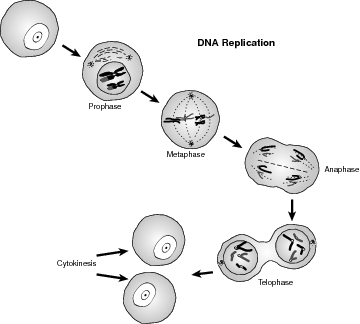Cell Theory, Form, and Function: Cell Cycle: Interphase, Mitosis, Cytokinesis
Cell Cycle: Interphase, Mitosis, Cytokinesis
Each eukaryotic cell has a repeating set of events that make up the life of every cell, called the cell cycle. Although they vary in length depending upon the cell's function, the cell cycle for all cells can be described in five steps. The first three steps where the cell grows, matures, and carries out its life function are collectively called interphase, followed by mitosis, and cytokinesis. Refer to the illustration Cell cycle.

Interphase, Mitosis, Cytokinesis
The interphase continuum of stages, G1, S, and G2, begins the process in which the cell grows and matures (G1), followed by the S phase in which the DNA is copied. Finally, the G2 phase is when the cell prepares for division. Mitosis occurs when the nucleus of the cell divides into two identical nuclei with the same number and type of chromosomes, followed by cytokinesis when the cytoplasm, for both plant and animal cells, divides, thus creating two daughter cells that are genetically equal and approximately identical in size.
Cell Cycle Regulation and Cancer
Cells regulate their cell cycle in two distinct ways:
- During G1, when the conditions are favorable, certain proteins stimulate the cell to begin copying the DNA (S phase). Likewise, if the cell is not healthy or large enough, or the environmental conditions are not favorable, the cell cycle stops here to prevent cell injury.
Biohazard
Although mutations occur spontaneously in nature, environmental factors may increase their incidence, such as the use of tobacco products, overexposure to ultraviolet light and other type of radiation, and certain viruses.
- The cell cycle can also cease during the G2 phase at the DNA replication site. If the DNA is determined to be without blemish, the process continues, if damaged, the cell cycle is suspended until the DNA can be repaired.
If a mutation occurs in one of the genes that controls or regulates cell growth in any number of ways, the corresponding protein may not function correctly, allowing the cell cycle to proceed without interruption. Cancer is a cell-division disorder that results in uncontrolled cell growth.
Asexual Reproduction
When an organism reproduces offspring without the union of gametes, then asexual reproduction has occurred. Gametes are sex cells that are either sperm (male) or egg (female).
Asexual reproduction guarantees that the offspring will be both genetically and structurally identical to each other and their parent. It also allows one parent to rapidly produce offspring, which can be an ecological advantage when exploiting a new ter-ritory. For instance, the foxtail plant is considered a “weed” in certain parts of the Midwest. It is an annual plant that is able to produce enough seeds to cover an exposed area in one growing season. In one sense this is good, because it may prevent erosion; unfortunately, the area covered by the foxtail may be a farmer's field.
It also increases the likelihood that the species will survive, simply because of massive numbers. The identical nature of the offspring is also a potential drawback because of a major change in the environment, or the blanket use of a biocide, or a hungry predator.
Asexual reproduction produces offspring in four distinct methods:
- Budding is when offspring begin as outgrowths or “buds” of the parent. When mature, they drop off and grow into a mature adult. Budding is common in Porifera, like sponges.
- Fragmentation is common in cnidarians and some worms, and occurs when a piece or pieces of an organism are cut off or broken off from the main body. The fragmented piece then grows into an adult.
- Binary fission is a combination of mitosis and cytokinesis because an organism simply divides into two organisms, especially common in flatworms.
- Parthenogenesis is the deposition of unfertilized eggs, often by insects, which grow into adults.
In every case, the offspring are identical to the parent and to each other.
Excerpted from The Complete Idiot's Guide to Biology © 2004 by Glen E. Moulton, Ed.D.. All rights reserved including the right of reproduction in whole or in part in any form. Used by arrangement with Alpha Books, a member of Penguin Group (USA) Inc.
To order this book direct from the publisher, visit the Penguin USA website or call 1-800-253-6476. You can also purchase this book at Amazon.com and Barnes & Noble.







